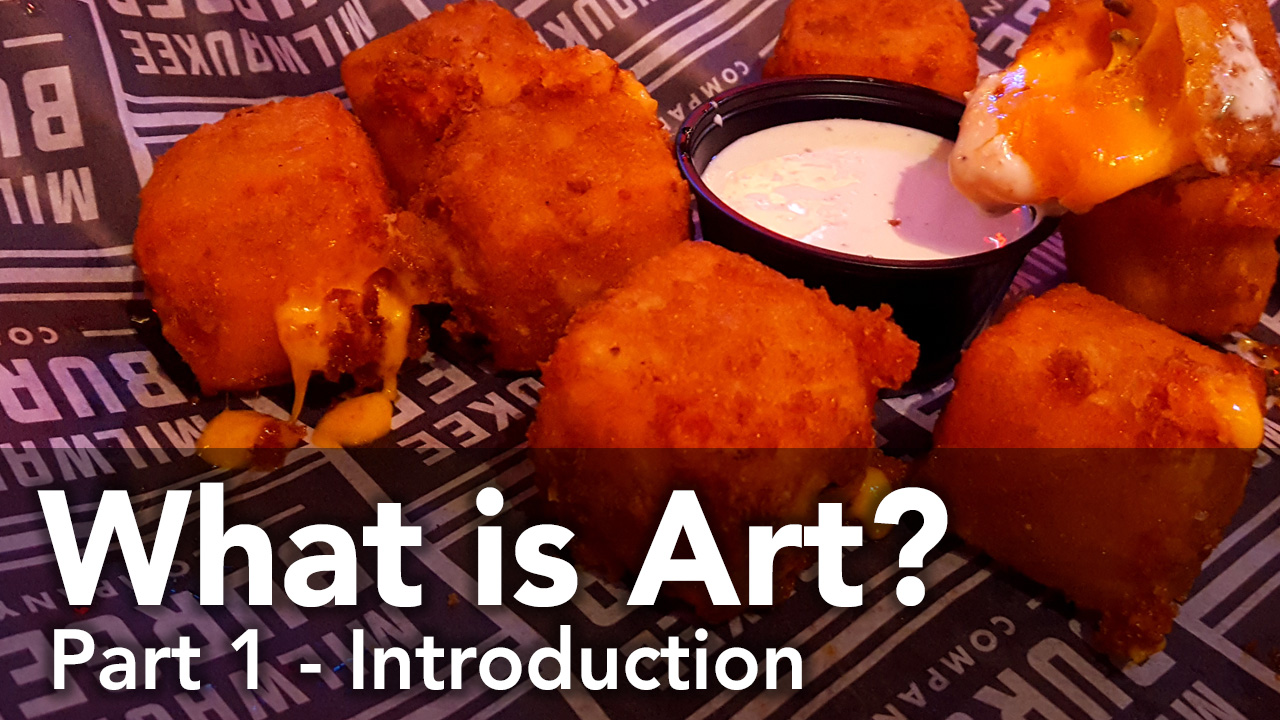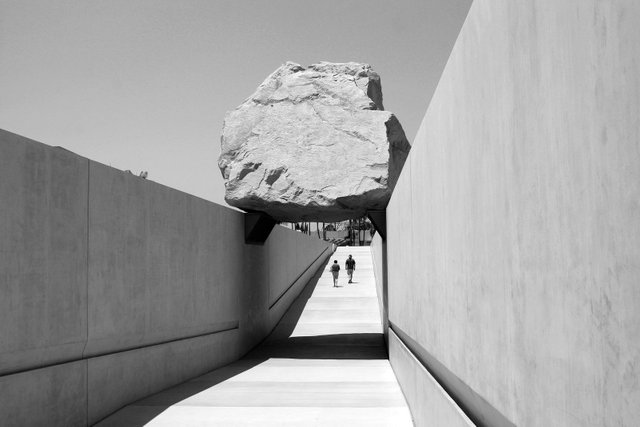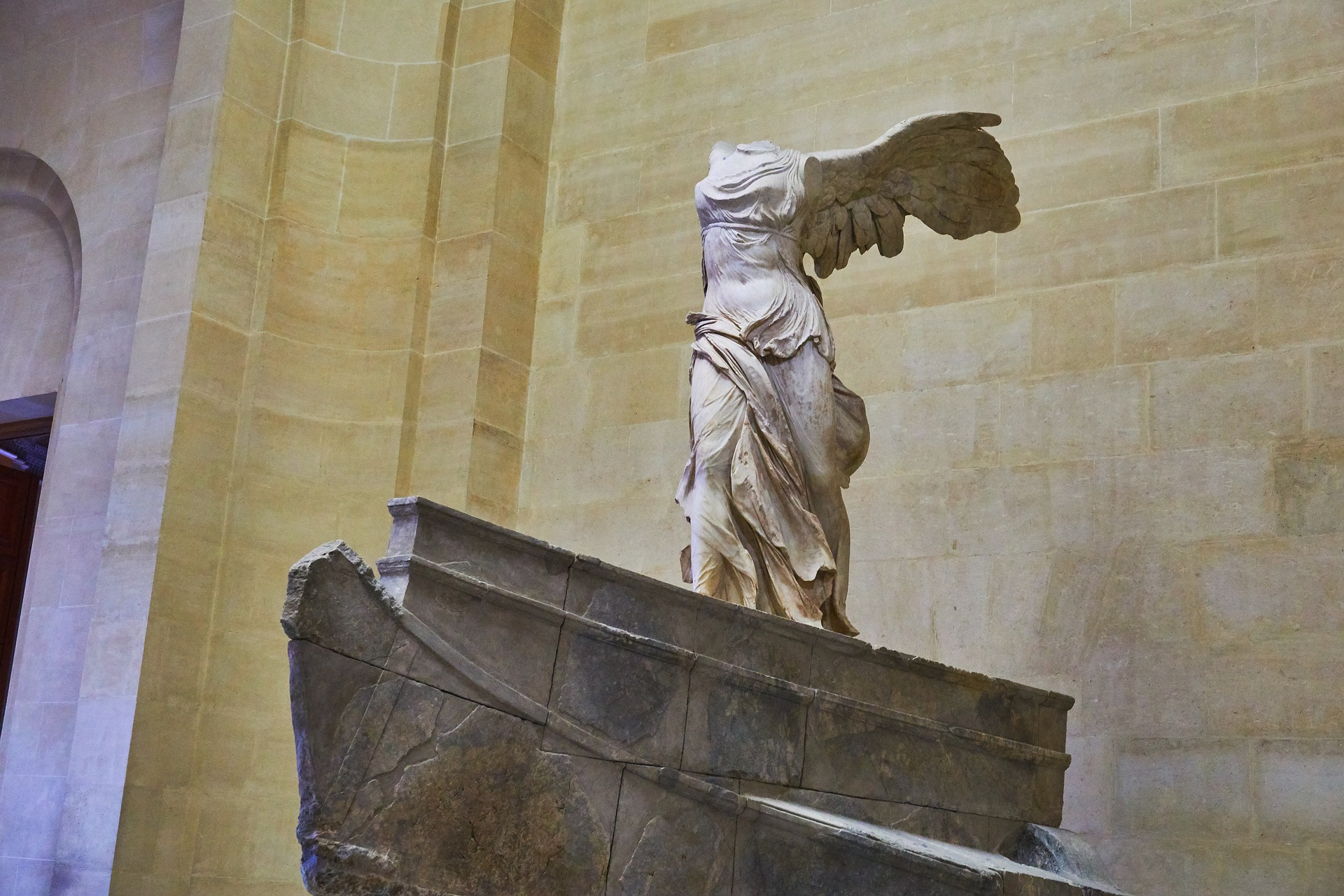What Is Art? - Part 1 - Introduction
Last night, my husband @negativer and I were at one of our favorite local hangouts, Milwaukee Burger, trying to warm up over a glass of imperial IPA and a stout, respectively, and a plate of deep fried cheese curds. As is the way of two people drinking beer, many deep thoughts were exchanged, and many thought-provoking topics were explored.
Then I asked this question:
“What is art?”

A long debate between us ensued. Music, sculpture, painting, writing, when does something become art, and how do you measure that?
As a pianist and singer myself, I struggle with defining when something that is created becomes art.
I know this has been asked and answered to varying degrees of success by artists and philosophers over the centuries, but to me it seems much more relevant to ask this question today when art, in my opinion, seems to be much more elusive. The answer, it seems, requires answering quite a few more questions, like:
- If you assume that something like a blank canvas is not art, and pieces like Botticelli’s painting, The Birth of Venus, is art, then at what point does something become art?
- If a person makes a quilt or crochets a pillow that shows a mastery of that craft, is that art or simply a “craft”?
- Is there a difference between something that is “art” and something that is “artistic”?
- Does art by definition have to contain beauty, and what is beauty anyway?
- Should art invoke a feeling or transform the audience in some way?
- What does the phrase, “Art for art’s sake?” mean, and is it true of the purpose of art?
Let’s look at a few examples
For instance, this sculpture is on display at the Los Angeles County Museum of Art:

Levitated Mass by Michael Heizer, 2012. Photo by Ron's Log - Source
Then, compare it to a sculpture that has stood the test of time - not physically, but as being appreciated as art:

Nike of Samothrace Anonymous. Source
Or in another medium, listen to these examples of music:
4'33" by John Cage. Source
If you’re not hearing anything in the second video, it’s because that’s how the piece is actually “performed”.
I don’t think there’d be any disagreement in my saying that the sculptures are very different from each other, and the music couldn’t possibly be any more different.
Aesthetics, Shmaesthetics
One can simply excuse this as having a different aesthetic, but the issue goes deeper than that. Certainly there were different aesthetics in various eras in art. Compare the Classical Period in music, which dates from around 1730-1820, that was formed in reaction to the music of the previous era, the Baroque Period (1600-1750). Composers like Johann Sebastian Bach epitomized the Baroque sensibilities, and yet his music was looked at with disdain by many Classical musicians and critics.
Now, the works of J.S. Bach are idolized by serious classical musicians today (Note: I will use the lower case C to refer to music of traditional acoustic instruments, which is generally historical music taught at conservatories and universities. I reserve the term “Classical” with a capital C to indicate the musical period). In today’s classical music scene, however, you will rarely find composers who are writing in a Baroque aesthetic except as an exercise or as a direct imitation.
Aesthetics change over time, and that is certainly an acceptable idea. But what truly distinguishes a great piece of work? The above examples show not only a changing of aesthetics, but a complete change in fundamental principles of art that have existed for centuries until around the 20th century.
What’s Next?
In this What is Art? series, I will use known famous artworks of past and present to discover what these historic fundamental principles are, and explain why modern art is violating these principles and what possible effects that has on society.

If you enjoyed this post, please follow, upvote, and resteem. I write posts on singing, playing piano, teaching music, and short stories about anything.

My understanding is that most people, if not everyone, produces artistic content fluidly throughout their days.
Whether or not that art is documented, complimented, seen, produced on purpose, posed for, manipulated, cheated stolen or just experienced; most things around you including you are art.
What if I'm looking at a rock. I didn't place it there, nor did I create it. If you believe in God (which I do), then you could certainly say God created it. It may be beautiful and I may enjoy looking at it, and it may even serve a purpose as decoration or as a doorstop. But is that "art"?
I do feel that nature, Creation, itself is what art seeks to imitate or allude to. Take the Golden Mean, for example. It is found in the nautilus shell and many other examples. Art that imitates/adheres to that "rule" as one of its principles (but not only that) is a component found in many great historical works of art.
So personally, I feel that nature and the world around us is a great source of inspiration and understanding, but I feel that art itself comes from an expression of that.
I look forward to reading the next one in the series. This ought to be good.
For the record, although those cheese curds were good, and relatively pretty, they were not art.
Why not? Because it's food? I think food is an art too: culinary arts. Perhaps not the most refined thing a person could eat, but they were mighty satisfying.
Very interesting and thought-provoking post @morodiene. Also 10 out of 10 for you and hubby spending time together like that!
There's no one I'd rather spend time with :)
An an artist, of course, I'm very interested in this topic. You've already opened up the discussion wonderfully. I've often wondered myself...what is art?
Unfortunately, I believe the short answer is: art is whatever an artist creates to be considered art and what a society says is art.
The question becomes more: "What is good art?"
But even then, a society can reject the norms of what was previously considered good art, and install a new norm. And we have seen that in the last 150 years or so, with impressionism, post-impressionism, fauvism, cubism, abstract expressionism, etc.
Although at one time, representing reality accurately, even if idealistically was the goal in creating good art, it was thrown out in favor of subjectivity.
So, "it's good if I say it's good, and I can sell enough people on the idea that it's good."
This devolution of art correlates with the devolution of objective truth within society as a whole. Today, we say there are no standards of what is right and wrong--even though there still are--and so you create what you want without following the rules.
In fact, we have paid homage to the artists that have consistently broken the rules--they are the ones that often make it big. Jackson Pollock was one example, who completely rejected pictoral representation as the goal of his drip paintings, and instead decided to create rhythm and design only.
Damien Hirst is a contemporary example, who rejects just about anything "decent" and creates art for shock value.
So, anything is art if the artist created it to be art and enough people accept it as art, but not everything is good art. Even if enough people say it is good, it still is not good, if it defies fundamental concepts of what good art is.
What are the standards or fundamentals of good art?
I'll leave that to you to elaborate more on...
I look forward to your series. This will be a great discussion. Upvoted and resteemed!
Wow, great reply, Matt. I do think that the question comes down to "good art" vs. "art," but my hopes are that through this discussion I can possibly nail down some elements of what makes "good art" by defining first, what "art" is. Once the criteria of "good art" is established, then I don't think one can call anything art that they feel is art - or at least get anyone to agree with them.
I look forward to hearing more insight from you!
But if 'criteria' for good art were ever nailed down, anyone could make good art instantly. And it would become valueless and meaningless. So it's Catch 22 - the reason we have good art, is because it's impossible to nail down. :)
I respectfully disagree: I don't think that by understanding what aspects that make great art it will make it so that anyone can do it. I think that there are intangibles like having a vision and the ability to execute that vision accurately that even if defined not everyone can do it.
Nor do I think by defining something it makes it meaningless. IMO, some things that pass for art these days is extremely meaningless, and I believe it may be that way as a result of not defining what's "good art".
I appreciate your input and hope you continue in future posts - "iron sharpens iron" after all! :)
Art is definitely subjective. I tend to consider anything genuine to be art. But concepts that are meant to challenge the norm, like a silent concerto don’t fit the bill for me. I tend to have a low threshold for “conceptual art”. If it looks or sounds like garbage, I am loathe to call it art.
Yes, and while I do agree art is subjective, I do think that there are some distinct properties of great works of art that have survived that speak more to what humanity needs or gets out of art. There's a lot of music out there that I can appreciate for what it is, but I may never choose to listen to it. Then there's stuff that doesn't seem to even be trying .
I agree completely.
I love me sum Milwaukee Burger Co. I was there at the beginning of December. I had the Sriracha Pork and Pineapple burger with a Nitro Oatmeal Stout. It was good. And yes, I considered my food and beer to be very inspiring, so I consider it art, for that reason alone. Art should inspire or at the least move you emotionally, IMO.
That burger sounds awesome! Maybe I'll try that this summer (not sure we'll make it back there before we head back to warmer climes). I feel the same way about food, and yes, I agree that there's some place for art to be inspiring or moving to the consumer.
I made my self this question many time, even trying to set the line between what's art and what's not just to find out that's it wasn't the same for everybody. I think it's a common interest topic, thanks for bringing it out! Curious to see the rest
I do think that there's plenty of room for individuality and subjectivity, and that not all people will agree in the end on perhaps even the principles that I think are valid. But hopefully asking the question will spark people to think more about it in general and not accept just anything as art because someone says it is so (myself included). :)
a very unusual and original point of view)
I like people who have non-standard vision
Thanks for reading!
You got a 1.47% upvote from @upme requested by: @kubbyelizabeth.
Send at least 1.5 SBD to @upme with a post link in the memo field to receive upvote next round.
To support our activity, please vote for my master @suggeelson, as a STEEM Witness
Kubby, you are so sweet! Thank you!!
Interesting post topic. I have wondered that as well. I believe art is intentional effort to an end above and beyond functionality. I remember my mom calling someone who was styling my hair for a dance an artist. It seems like the rule applies. In another example, someone could just build a shelter, roof and walls, but intentionally considering balance, proportion, colors, textures and the like, is considering an end beyond functionality...that makes art in my opinion. Good post! Upvoted and resteemed :)
Interesting. I do think intention should play a part in it, but let's take Jackson Pollock or any aleatoric means of creation. Is that then, not art, since there's no intention behind it (except the means by which the composer/artist chooses the method of creation)?
What you point to is someone making decisions based on a set of rules or principles (balance, proportion, contrast, etc.) -- whatever the artist deems important. Or are there a set of fundamental principles in art?
I believe it is whatever the artist deems important, based on their intention. Photography would be another interesting type to consider. Some artists take photos of beautiful things, or mundane, but there is an intent for them choosing this or that, and how they process it, crop it, display it, etc. They could even have a camera take pictures randomly at a set location, but there would have to be some intentionality in why they select particular shots out of the random. In my opinion, art is good when an artist executes their intentions well, and not good when they do not.
Urine in a jar with a crucifix (I don't even want to mention the name)? It probably meets your criteria, but personally, I wouldn't call it good art. >_<
Ew! But really, but what is the point of such a thing? I do think people will have wildly different ideas of what good art is. And that's okay.
I wonder also if a recipe would be a good analogy to art. What makes a good recipe? Some might really enjoy fruitcake, while others find it quite unappealing. Some really like sushi while others don't. Or hot ghost pepper salsa and so on... But, there has to be skill in execution of the intention. And, I think there must be some line in which all would agree something is unappetizing...for instance, something is undercooked or overcooked or an ingredient is added into a painful degree. For instance, a cup of salt in a cake recipe. So there are boundaries to make a recipe "good." It can't just be if the masses agree it is good.
Right, and luckily, we have many "dishes" that over the centuries, people have agreed are good. So by looking at how those dishes are composed, one may get a glimpse into what makes a good recipe.
I think for some it may be threatening to watch the sausage being made, but then you will learn what makes a good sausage, or how to make it better - which are both good endeavors.